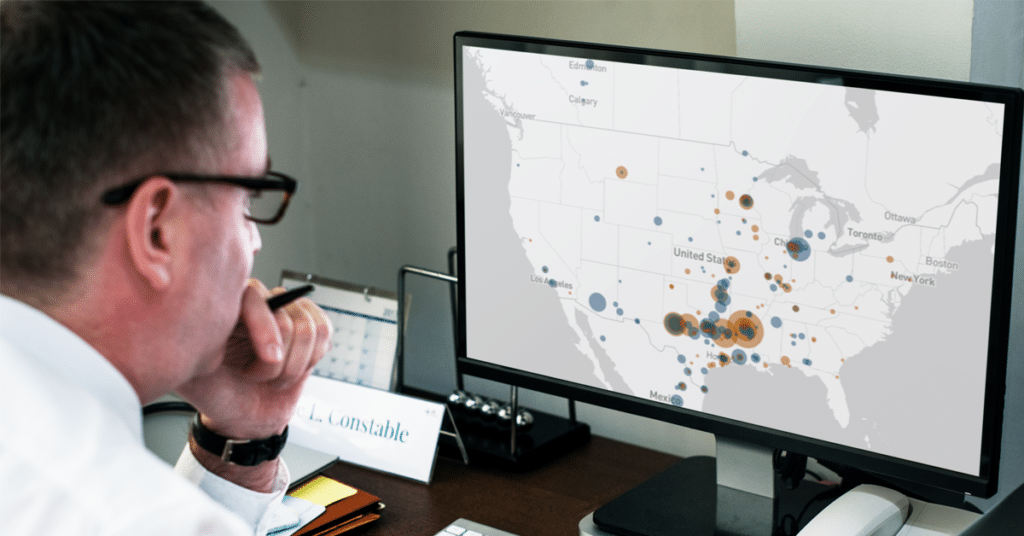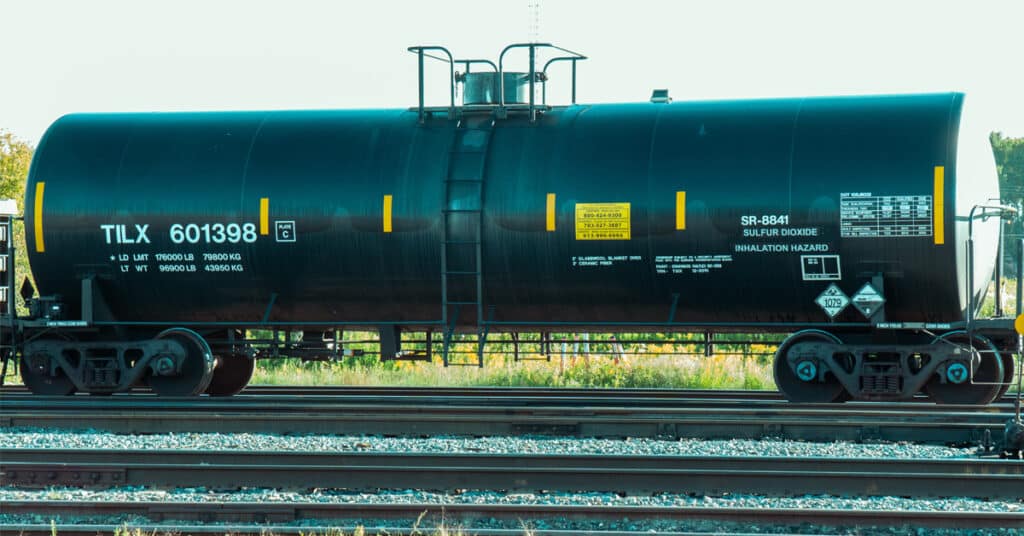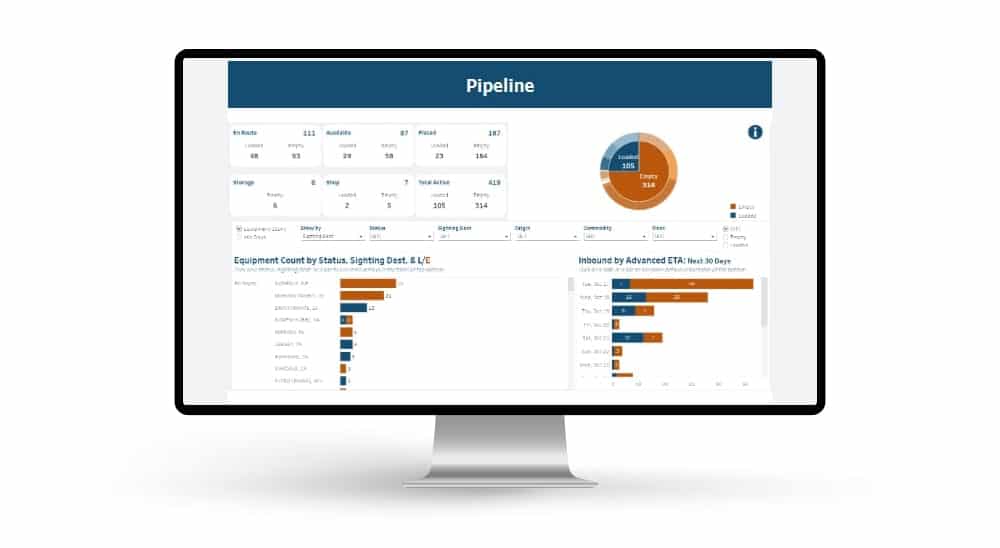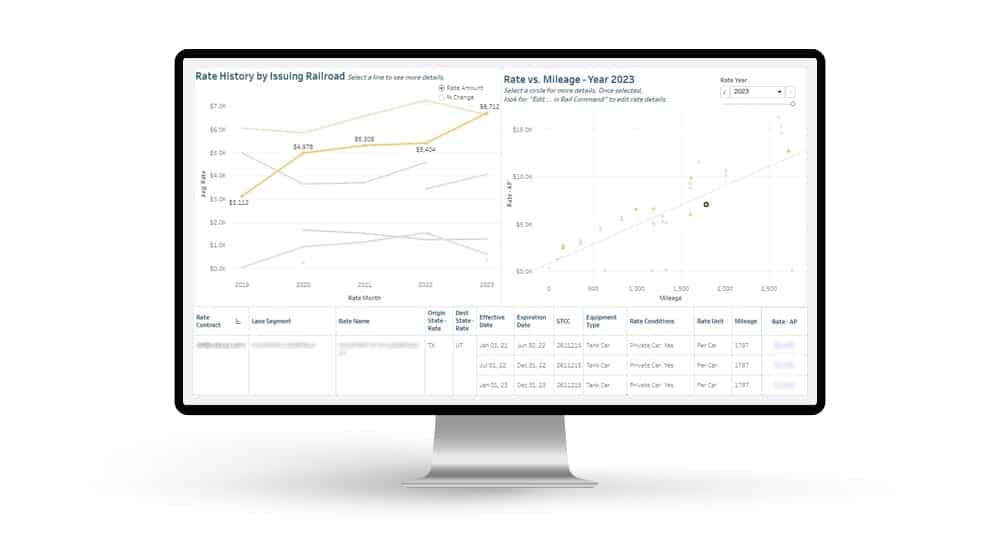Effective tracking and tracing of rail freight is essential for seamless transportation operations and cost control. As the rail industry continues to evolve, leveraging data analytics offers rail professionals a new way to improve the quality and efficiency of their tracking processes. This blog explores the role of data analytics in rail freight tracking and tracing, demonstrating how its strategic adoption can significantly impact a company’s bottom line.
The Imperative of Rail Freight Tracking and Tracing
In the realm of rail freight, the significance of proficient tracking and tracing operations cannot be overstated. While these processes may seem straightforward, they are, in reality, beset with a number of challenges that can hinder operational efficiency and profitability.
First and foremost, the sheer geographical expanse of rail networks makes it difficult to maintain visibility of all railcars. Traditional methods of tracking—while functional—often rely upon periodic updates rather than delivering a continuous stream of data. This lag in information can result in mismanaged resources, delayed operations, and ultimately, lost revenue.
Secondly, the industry grapples with the issues of manual data entry errors and fragmented communication platforms. Discrepancies in data analysis and reporting can translate into misinterpreted or delayed information, creating inefficiencies that can take a toll on operational productivity.
Lastly, the dependence on legacy tracking systems poses a challenge. Such systems often lack integration capabilities with modern technology platforms, constraining the rail freight operations to be reactive rather than proactive.
These challenges, if not addressed promptly, can have large cost and efficiency implications. Inefficient tracking systems can result in irregularities in the transit – such as delays and misplacements – and administrative errors. These operational setbacks not only disrupt service quality but also escalate operational costs including labor, fuel, and maintenance overheads.
Highlighting the financial impact, an inefficient tracking system can reduce a company’s efficiency, which can in turn directly hit its bottom line. Being competitively marginalized in an industry where speed, timeliness, and reliability are paramount can lead to lost business opportunities and severely limited growth prospects.
Data Analytics: Unlocking Advanced Tracking Capabilities
As we delve deeper into the era of digital transformation, data analytics becomes an essential player – a strategic enabler in the freight rail industry. But what is data analytics exactly in this context?
Data analytics, in the most basic terms, involves the study of raw data to uncover meaningful trends, patterns, and insights. By focusing on the freight rail industry as an analytical framework, we can tailor these insights to bolster the efficiency and effectiveness of rail operations.
Let’s explore the direct applications and how they can augment traditional tracking and tracing methods:
Predictive Analytics
Data analytics is not solely about understanding the ‘now’; it’s also about anticipating the ‘next’. Predictive analytics, leveraging machine learning algorithms, can identify potential issues before they emerge, allowing rail operators to make proactive, not reactive, decisions. For instance, by examining historical data, predictive models can alert rail professionals about possible component failures, railcar availability, or impending traffic bottlenecks, allowing for preemptive maintenance planning and optimal allocation of resources.
Real-Time Monitoring
When it comes to rail freight tracking, time is literally money. And real-time data analytics is a game-changer in clock-bound operations. By analyzing data as it is generated, real-time analytics enables constant visibility into the location and status of each railcar, fostering quicker decisions and immediate responses. No more waiting for periodic updates – this real-time data-driven approach ensures consistent up-to-the-minute intelligence, significantly reducing the risk of delays and their associated costs.
Benefits of Using Data Analytics in Rail Tracking
By harnessing the power of data analytics, the rail freight industry can unlock remarkable gains in efficiency, visibility, and cost control. These benefits can revolutionize the way organizations manage their railcar tracking and tracing processes, ultimately improving overall business performance.
1. Improved Efficiency
Advanced analytics algorithms, when integrated into existing tracking systems, can markedly enhance the efficiency of rail freight operations. By analyzing vast data sets related to routes, schedules, and cargo details, these algorithms facilitate data-driven decision-making in several key areas:
- Optimized Route Planning: Machine learning-powered algorithms can analyze historical data and real-time situational factors, such as weather and traffic conditions, to design the most efficient route for each railcar. This results in minimized transit times, better resource utilization, and ultimately, increased productivity
- Bottleneck Detection: By identifying potential chokepoints in advance, data analytics empowers rail professionals to take proactive measures to prevent congestion in their rail networks. This circumvents disruptions to service quality and helps maintain continuous operations.
2. Enhanced Visibility
The utilization of data analytics in rail tracking offers unparalleled visibility into railcar movement, granting industry professionals an in-depth understanding of their assets’ status and location. Real-time monitoring of railcars provides several benefits:
- Timely Decision-Making: With continuous access to up-to-date information, rail professionals can stay agile in their decision-making, responding promptly to unforeseen events or concerns.
- Improved Stakeholder Communication: Enhanced transparency through real-time analytics eases communication with clients, suppliers, and other stakeholders, ultimately fostering well-informed collaboration and stronger relationships.
3. Cost Control
Strategic employment of data analytics in rail tracking has a direct impact on cost savings and returns on investment. By streamlining operations and mitigating risks, rail shippers can unlock tangible economic gains:
- Reduced Operational Costs: Identifying inefficiencies in rail operations helps lower overheads related to labor, fuel, and maintenance expenses.
- Enhanced Risk Management: Mitigating risks through proactive monitoring and predictive maintenance reduces the likelihood of costly accidents and delays, safeguarding a company’s financial position.
The transformative power of data analytics in railcar tracking and tracing is well-documented in numerous case studies, proving its potential to generate tangible results within the freight rail industry.
Not Required, But Essential: The Case for Voluntary Adoption of Data Analytics
Even though data analytics may not be mandated by legislation in rail freight operations, its adoption offers innumerable benefits that can revolutionize the way businesses manage their supply chains. Data analytics delivers actionable insights, aiding in critical decision-making processes, thereby improving operational performance and maintaining cost control. Early adopters of this technology gain a significant competitive edge, allowing them to optimize operational strategies and surpass their competition in this incredibly complex transportation mode.
Leveraging the potential of data analytics facilitates real-time visibility, predictive maintenance, and enhances asset utilization across the rail network. By translating raw data into meaningful interpretations, rail freight companies can make informed predictions about potential problems or bottlenecks and address them proactively before they elevate into more significant issues.
Rail Command®: Your Partner in Efficient Rail Freight Tracking
At RSI Logistics, we empower organizations with pioneering software solutions engineered to harness the full potential of data analytics, refining the art and science of rail freight tracking. Our platform, Rail Command®, features comprehensive functionalities including real-time tracking and highly accurate analytics, designed to cater to the dynamic needs of the modern rail industry.
We employ advanced algorithmic models to analyze data, providing dynamic reports and delivering actionable insights straight to your dashboard. Thus, Rail Command® acts as your knowledgeable partner, offering valuable insights and solutions, enabling you to tackle challenges head-on, and improving your operational efficiency, fleet utilization, and overall cost control.
Beyond these options, Rail Command® offers a suite of services tailored to your specific needs. From shipment visibility, route optimization to fleet maintenance, our software solutions provide the data-driven insights required to streamline operations and enhance profitability.
At RSI Logistics, we focus on more than just offering an outstanding product—we are committed to creating a productive partnership with our clients, helping you navigate the labyrinth of rail logistics with confidence and precision. Our goal is to revolutionize the rail freight industry, by transforming complexity into simplicity, and challenges into opportunities.
Data analytics presents a valuable opportunity for rail freight companies to advance their tracking and tracing capabilities, driving efficiency, visibility, and cost control. By adopting these advanced solutions and partnering with knowledgeable experts like RSI Logistics, shippers can ensure a profitable future in today’s ever-evolving rail space.




 Automated exception reporting of the railcar tracking data makes it easy to identify and troubleshoot jeopardized shipments, thereby enabling you to provide better service to your stakeholders.
Automated exception reporting of the railcar tracking data makes it easy to identify and troubleshoot jeopardized shipments, thereby enabling you to provide better service to your stakeholders. Receive notification of pending rate expirations. Tariff changes and fuel surcharges can be automatically updated.
Receive notification of pending rate expirations. Tariff changes and fuel surcharges can be automatically updated.